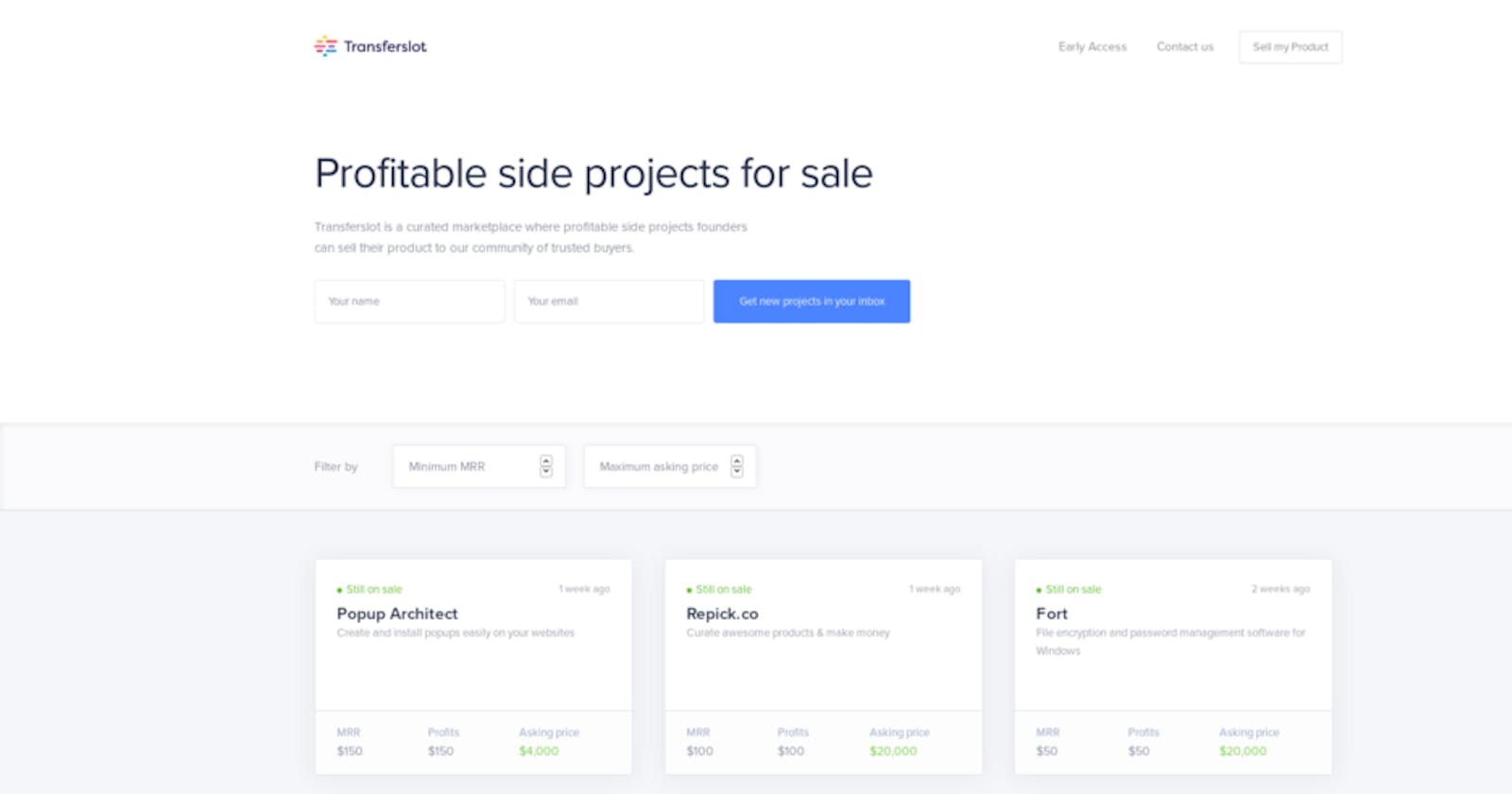We recently switched Transferslot to a new model, one that only accepts profitable projects. We know this is a big step and will greatly reduce the number of submissions, but on the other hand, the products that will be published will be of better quality, with a beginning of market validation and a potential for growth that are more interesting.
While making this decision, we had a long (and unfinished) talk about how we could monetize Transferslot in such a way that is a win-win for everyone.
Many ideas came up, and I think it’s interesting to share them here. It might help other owners of different marketplaces along with giving you an idea of what we thought of each possibility.
The obvious one: Listing fee
Of course, we could do like the main one does; asking for a payment when submitting a project.
Having been on the seller side of Flippa, I know that I didn’t mind much about paying for listing my project. I had a fair idea of how much it would cost, how much I would gain from it so I was able to make a rational decision on how which option to choose.
The issue is that it’s 1) not the case for everyone, 2) doesn’t guarantee you a successful sale.
The point 2 is, for me, the most important one here! We don’t think that it’s fair as a marketplace provider to ask for payment for something that might not work. We want our seller to be happy if they pay us, not crossing fingers and hope for the best.
Paying for options
One of the things we offer right now, and one that I like quite the most, is offering the listing for free but offering options that aren’t free.
Two things we currently offer are the option to be private, and being on a dedicated newsletter.
The dedicated newsletter is really interesting because it clearly shows the interest for the seller (increased visibility) and can easily justify the cost (currently at 50$).
That’s one strategy that Flippa implements too (even though their price for having a dedicated newsletter are way higher, but they also have way more subscribers!).
Limiting the number of buyer’s requests.
One other option we discussed, and almost implemented, was to allow for three buyer’s requests to be sent to the seller, then block the future messages.
If the seller wanted to read them, he would have to pay us to “unlock” the pending messages.
At first, it looks like the listing fee option; There is still no way that the sale will be successful, and it’s true. The reason why we still thought it would be a good idea was that with the listing fee, you don’t have a clue about the potential of your sale. With this solution, if you have more than 3 requests, it means you got some interests, and thus a higher chance to sell.
One con about it is that if the seller doesn’t decide to pay, the potential pending buyers won’t receive a response and will think that either the seller or Transferslot, ignore their messages. This is not great. (Of course, we could handle the pending message after a certain time, but it requires more work that aren’t really necessary in that case).
Three alternatives are possible in this possibility, such as :
- Allowing for 3 free messages before blocking the next ones
- Hiding name and email from the beginning. The seller would have to pay to get the detailed information (same issue as the listing fee)
- Block from scratch (same issue as the listing fee)
Relying on trust
This is one of my favorites, even though it has a high chance of not working.
The idea is simple: We would ask our sellers to let us know once their project is sold (they are kind of required if they want the project to be removed/updated on Transferslot). Once we acknowledge that the sale was successful thanks to Transferslot, we can request the seller to pay us a fee (15% for instance) of the sold price.
The issue here is that:
- We can’t enforce a seller to pay us
- They can lie, saying they sold outside of Transferslot.
That’s the reason I named this part “relying on trust”. Maybe not all the sellers will pay, but if a few do, it will still be beneficial.
Being legal
Improving the “Relying on trust” part, we could require our sellers to sign a document which engages themselves on having to pay a fee if we successfully help them make a sale. Having to sign this document will enforce the seriousness of it and will decrease the risk of user avoiding to pay the fee.
Being the middleman
Another solution would be that instead of buyers reaching out directly to sellers on Transferslot, it would be us that receives the messages. We would either reply directly if we already know the answer or reach out to the seller for more details.
Of course, buyers could contact the seller directly from their website since the data aren’t hidden, but we would rely on the fact that it’s easier for the buyer to just fill the form on Transferslot’s website instead of having to search for contacts credentials.
One of the cons here is that it will require a lot more work on our side, with a low response time. But on the pros, working as a middleman will give us the chance to better handle the sales, eventually catch bad sellers faster, and requesting a fee upon successful sale.
Being an escrow service
Finally, one of the most advanced way we can earn money while sharing a win-win with our customers.
By implementing two of the discussed options here; Being legal and being the middleman, we will ensure that the transaction occurs and it will help us identify any issues, work with both the seller and the buyer.
This will also provide a chain of trust as we will manage the whole transaction and ensure everything goes smoothly. Along the transaction, taking a fee will be easy and evident.
But there are big disadvantages to doing so. The first one is the time involved. We won’t handle one project at a time, but multiple. Managing the discussions between the sellers and buyers, hoping we don’t mix the projects and provide incorrect numbers.
Moreover, by being in the middle at this level, we engage ourself legally too. If the sale goes south and one member has already invested in it (paid the price or send all their code for instance), all the issues might fall on us. At this level, I’m not talking about small angry emails, but a potential lawsuit!
Even though that’s clearly the best option there, it’s also the riskier. That’s why we haven’t done it yet.
Conclusion
We still don’t know our next move regarding Transferslot. The difficulty here is that we are in the middle, between Flippa and FEInternational, and we can’t implement all the options.
I think we need to find what service we want to provide from A-Z and use a revenue model that fits greatly with the service. There are a lot of options here, some more honest than others, and that a key point — at least for me — honesty.
Thanks for reading, I hope it was helpful for you. If you have any other ideas we could implement, I’d be happy to discuss them with you. It’s also not impossible that we try some of the mentioned methods in the future on Transferslot, and see which one works best.

